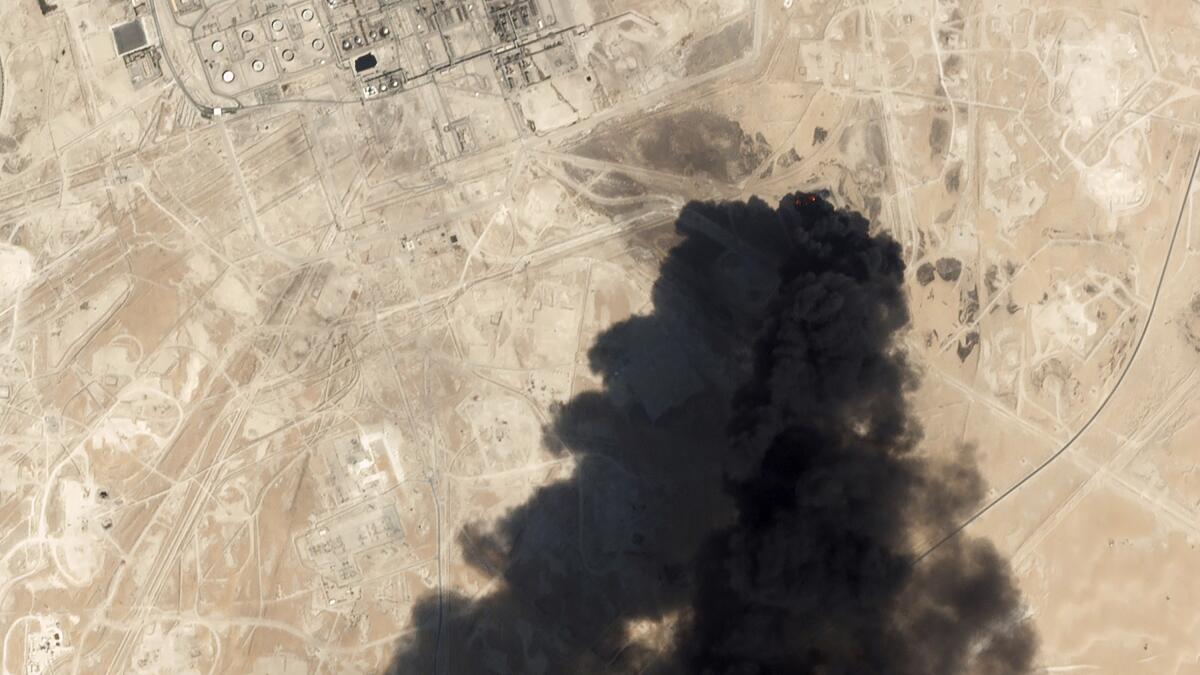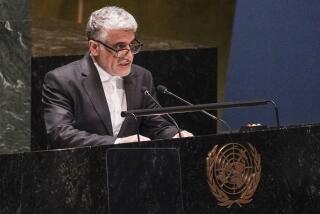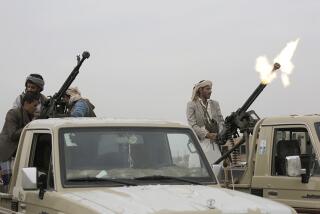Trump says ‘no rush’ to respond to attacks on Saudi oil facilities

President Trump said Monday that it appears Iran was behind air attacks on two major Saudi Arabian oil facilities, but he emphasized that he wants to avoid a new Middle East war even as he stressed that the U.S. military is ready for action.
Trump also appeared to look for a way to ease the latest tensions, saying “diplomacy is never exhausted” and that he was in “no rush” to decide on a response.
For its part, Iran denied responsibility for the attacks and ruled out a potential meeting between Trump and Iran’s president, Hassan Rouhani, on the sidelines of the United Nations General Assembly next week in New York, closing off a potential high-level outlet to resolve the crisis.
The predawn attacks Saturday caused a spike in global energy prices, with oil up nearly 15% on Monday, and the Brent benchmark seeing its biggest jump in about 30 years, rattling stock markets.
Secretary of Defense Mark Esper and other senior officials briefed Trump at the White House on what Esper called “this unprecedented attack.” Esper also spoke by phone with the Saudi crown prince, Mohammed bin Salman, and Iraq’s minister of defense, Najah Shammari.
The depleted White House national security team — Trump’s national security advisor, John Bolton, was abruptly ousted last week — scrambled to present options to the president as intelligence agencies reviewed satellite photos and other data to try to confirm the source of the attack, which U.S. officials believe involved explosives-laden drones and possibly cruise missiles.
The chief target was the oil processing facility at Abqaiq, which is responsible for half of Saudi Arabia’s daily exports and is the world’s largest oil processing site. Damage was also reported farther west at the Khurais oil field, where there were fires. Both facilities are operated by energy giant Saudi Aramco.
The Saudi Ministry of Foreign Affairs said Monday that the attack involved “Iranian weapons” but provided no details. No one was injured in the attacks, and Saudi officials said the fires were quickly brought under control.
Analysts documented multiple impacts at Abqaiq — mostly in spheroid-shaped structures — and at Khurais. A senior administration official said “multiple long-range precision-guided systems” were involved and the attack appeared to come from the north or northwest, suggesting weapons were launched from Iraq or Iran.
Houthi rebels in Yemen, which is hundreds of miles south of the Saudi oil fields, claimed responsibility on Saturday, saying they had launched 10 drones. But the Iran-backed militias have never conducted such long-range cross-border attacks in the past.
Secretary of State Michael R. Pompeo pointed the finger at Iran over the weekend.
“Iran has now launched an unprecedented attack on the world’s energy supply,” he tweeted. “There is no evidence the attacks came from Yemen.”
But Trump appeared less sure when he met with reporters at the White House.
“It’s looking that way,” he said. “As soon as we find out definitively, we’ll let you know.”
Trump said the U.S. would help Saudi Arabia, but he was equivocal when pressed about the possibility of authorizing military action.
“That was an attack on Saudi Arabia, that wasn’t an attack on us,” he said.
“If we decide to do something, they’ll be very much involved, and that includes payment,” he added. “And they understand that fully.”
Asked if he has promised the Saudis that the United States will protect them, he said, “No, I haven’t promised the Saudis that.... We have to sit down with the Saudis and work something out.”
At another point, Trump said, “I’m not looking to get into new conflict, but sometimes you have to.”
If Iran’s role is confirmed, the attack would represent a dramatic provocation and a direct challenge to Trump. Iran has repeatedly warned that it could disrupt global oil supplies if U.S. sanctions, which have effectively choked off its oil exports and chief source of foreign income, are not eased.
The region has been tense since last year when Trump pulled out of the 2015 nuclear accord with Iran and began imposing a thicket of punishing sanctions, grinding down Iran’s economy.
In recent months, Iranian security forces shot down an unarmed U.S. surveillance drone, seized a British oil tanker, and were accused of planting limpet mines that damaged four foreign-flagged oil tankers near the Strait of Hormuz, a strategic waterway.
Trump’s approach to Iran, like most of his foreign policy, has veered between confrontational to conciliatory.
In June, he approved and then abruptly canceled a missile strike on Iran meant to retaliate for the downed surveillance drone. Since then, he has repeatedly offered to meet face to face with Rouhani, even indicating last week that he would consider loosening sanctions to bring Tehran to the table.
On Monday he told reporters that the sanctions would remain in place and no meeting had been scheduled. But he said diplomacy is “never exhausted,” adding “I know they want to make a deal.... At some point it will work out.”
The likelihood of a meeting was never great given the decades of animosity between the two governments, and it appeared dead in the wake of the attack in Saudi Arabia.
“Neither is such a plan on our agenda, nor will such a thing happen,” Iranian Foreign Ministry spokesman Abbas Mousavi said, according to the state-run Fars News Agency.
Trump had already appeared to back away as well, tweeting Sunday that “the Fake News is saying that I am willing to meet with Iran, ‘No Conditions.’ That is an incorrect statement (as usual!).”
That was incorrect. Pompeo and Treasury Secretary Steven T. Mnuchin said at a White House briefing last week that Trump was willing to meet with Rouhani with no preconditions. And Trump had said the same thing on NBC’s “Meet the Press” in June, and then in comments to reporters in July.
Saudi Arabia said it would invite international experts to examine evidence from the attack.
On Monday, Col. Turki Maliki, spokesman for the Saudi-led coalition that is fighting the Iran-backed Houthis in Yemen, said initial investigations contradicted Houthi claims that the attack had come from Yemen’s territories.
Saudi Arabia has led a military coalition since 2015 to push the Houthis from the Yemeni capital, Sana. It also launched a brutal air campaign — with U.S. support — that has devastated the country, as well as a blockade that has left millions in Yemen on the brink of famine.
The Houthis have retaliated by peppering Saudi Arabia with explosives-laden drones and short-range ballistic missiles. Yet none were as effective as Saturday’s attack, raising doubts as to whether it was the Houthis who had conducted it or another one of Iran’s proxy forces in the region.
Tehran has established a diffuse network of irregular fighters from Lebanon, Syria, Iraq and Afghanistan. It has long viewed Saudi Arabia as a military and strategic adversary.
Speculation that the attack came from Iraqi territory spurred an unequivocal denial from Iraqi Prime Minister Adel Abdul Mahdi on Sunday. A day later, his office said Pompeo had confirmed to Mahdi that Iraq was not the source of the attacks.
Megerian reported from Washington and Bulos from Baghdad. Times staff writers Eli Stokols and Tracy Wilkinson in Washington contributed to this report.
More to Read
Get the L.A. Times Politics newsletter
Deeply reported insights into legislation, politics and policy from Sacramento, Washington and beyond. In your inbox three times per week.
You may occasionally receive promotional content from the Los Angeles Times.







